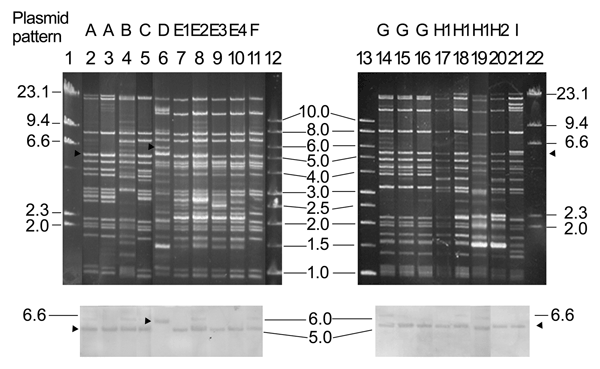Volume 11, Number 6—June 2005
Dispatch
Cephalosporin and Ciprofloxacin Resistance in Salmonella, Taiwan
Figure 1

Figure 1. . EcoRI restriction patterns of transferred CMY-2–encoding plasmids of 18 Salmonella isolates. The result of the hybridization assay with the blaCMY-2 probe labeled with digoxigenin (Roche Molecular Biochemicals, Mannheim, Germany) is shown below the gel, and arrowheads indicate the locations of the restriction fragments that were hybridized. Lanes 2–21, plasmids from transconjugants of Salmonella isolates NB04.022, SB04.003, NL04.050, SA04.028, CG04.039, SG04.039, SG04.042, SE04.006, SG04.047, SE04.005, NG04.011, NG04.016, NG04.018, NC04.001, NC04.002, NC04.003, NC04.004, and CE04.015; lanes 1 and 22, molecular marker II (Roche Molecular Biochemicals); lanes 12 and 13, a 1-kb molecular marker (Promega Co., Madison, WI, USA).
Page created: April 24, 2012
Page updated: April 24, 2012
Page reviewed: April 24, 2012
The conclusions, findings, and opinions expressed by authors contributing to this journal do not necessarily reflect the official position of the U.S. Department of Health and Human Services, the Public Health Service, the Centers for Disease Control and Prevention, or the authors' affiliated institutions. Use of trade names is for identification only and does not imply endorsement by any of the groups named above.